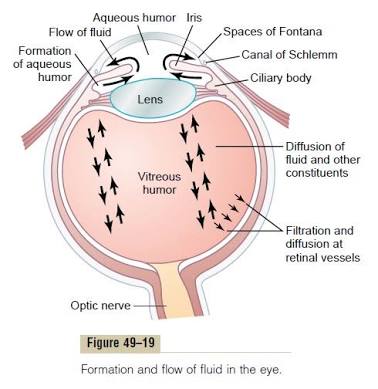
Fluid system of the eye
The eye can also be divided into two chambers, each filled with fluids. The vitreous cavity maintains the shape of the eye and is filled with a gel that is composed of many proteins and proteoglycans. The anterior cavity is filled with aqueous humor that wets the cornea and lens, providing these structures with the nutrients they need to function. Aqueous humor is secreted by the ciliary bodies, which are located behind the iris and are composed of secretory epithelial cells. Aquaporins are transmembrane proteins that facilitate the movement of water across the cell membrane wall. Aqueous humor flows from the ciliary processes, between the ciliary ligaments into the anterior chamber. Within the anterior chamber, aqueous humor can either pass through the pupil to wet the lens or remain in the anterior chamber to wet the cornea. After passing through the anterior chamber, aqueous humor passes through the trabeculae that act as a filter for the aqueous humor and then enters the canals of Schlemm. Intraocular pressure maintains the proper shape of the eye, helps in the aqueous humor flow, and is used as a measure of the hydrostatic pressure within the eye. When the inflow flow rate of aqueous humor and the outflow flow rate of aqueous humor are not balanced, the volume of the eye can increase.
by the end of this lesson, students should learn about
1. formation of aqueous humor
2. Drainage of aqueous humot
3. intraocular pressure


